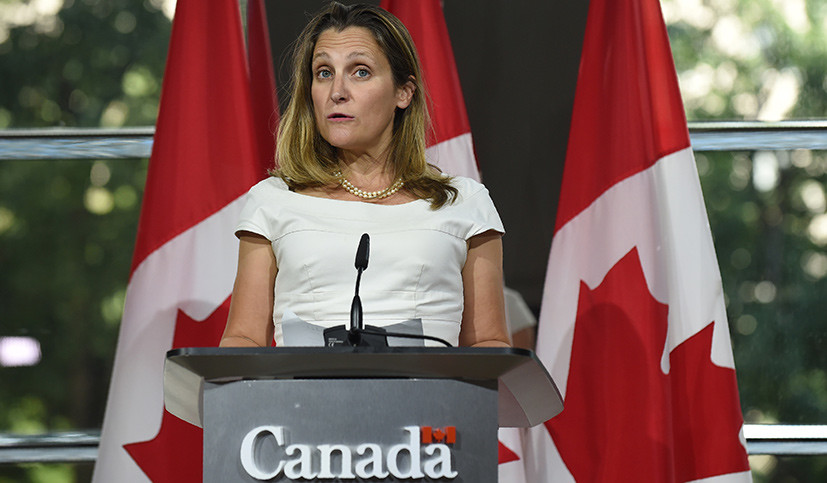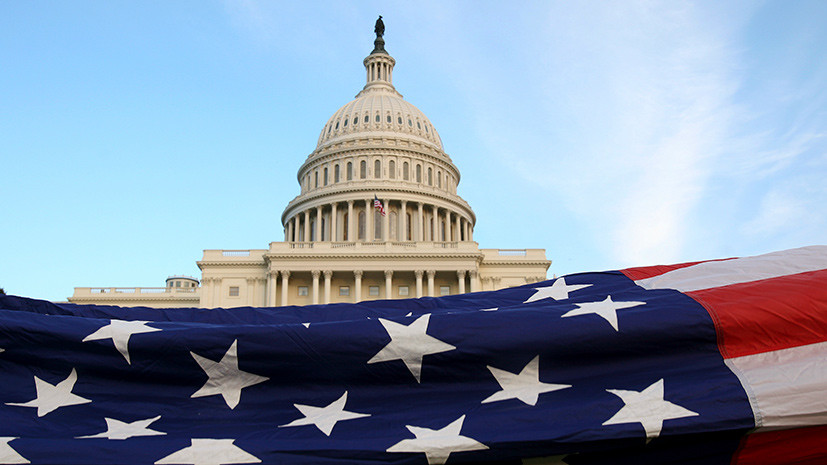The White House intends to sign a new trade agreement with Mexico and Canada within 90 days. The document will replace the Agreement on the North American Free Trade Area (NAFTA), effective since 1992.
According to the press service of US Trade Representative Robert Laitheiser, US President Donald Trump informed about the plans on the eve of the congress. At Lightheather's office, they stressed that the new agreement, if signed, would become "the most progressive" in the world.
The statement was made against the backdrop of the recent visit to the US of Canadian Foreign Minister Christy Freeland. The head of the Canadian Foreign Ministry discussed with the US Trade Representative the prospects for revising the trade agreement.
Speaking to reporters after the meeting, Freeland said that in the negotiations on NAFTA, the sides achieved "great progress".
"The fact that Mexico was able to do such a thing, it must be difficult for her to make concessions, really creates conditions for productive talks this week," she said.

- Christia freeland
- © Eric BARADAT / AFP
Discussion of the revision of trade relations will continue next week, a new round of talks is scheduled for Wednesday, September 5. This was reported on August 31 in the administration of the US President. Earlier in an interview with CNB, the US Treasury Secretary Stephen Mnuchin said that Washington and Ottawa could come to an agreement on a trade agreement in the very near future.
However, the Canadian side is not yet in a hurry to draw a line under the discussion.
As Freeland said on August 31, Canada seeks only a deal that will be of use to it. "We have not achieved this yet," the minister added.
A similar statement was made by Prime Minister Justin Trudeau. The politician stressed that he would sign the NAFTA deal only if the agreement was "good for Canada".
"Pristiazhnye belts"
Recall, August 27, Donald Trump announced that the US reached an agreement with Mexico on a new trade agreement. The politician explained that the countries decided not only to revise the trade turnover between the countries, but also to rename the document binding it.
"Earlier the agreement was called NAFTA, and we will call it the US-Mexican trade agreement. We will get rid of the name NAFTA - bad associations are associated with it, because the USA suffered a lot of damage because of NAFTA. And now we are making an excellent deal for both countries, "said the head of the White House.
Washington and Mexico City can sign a new agreement in November, explained the US trade representative Robert Lightheiser.
Canada can join this treaty, but Washington does not rule out a separate treaty with Ottawa.
"We can go to a separate agreement, and we can add it to this agreement - the US-Mexican trade agreement," Trump explained.
However, later in the media leaked a comment of the American president, not intended for the general public. Edition Toronto Star published the words of Trump, said by the politician not under the record in an interview with Bloomberg.
The politician said that he does not plan to seek a compromise on trade relations with Canada, but does not speak about it publicly, because "it will be so insulting that they can not make a deal."
Trump did not refute this information, but blamed Bloomberg employees for dishonesty.
"I made a statement denoting that it was not a record, to Bloomberg's agency about Canada, and this clear note was blatantly ignored ... At least Canada now knows what I think about it," wrote the US president in your Twitter.
According to experts, in an interview with Bloomberg Trump told the truth - the US administration can impose Ottawa and Mexico City almost any conditions.

- © Molly Riley / Reuters
"Mexico and Canada do not have the freedom to maneuver in trade negotiations with Washington," said Dmitry Evstafiev, professor at the Higher School of Economics, in an interview with RT. - Their economies are crocheted belts to the US economy. Their economic ties are not diversified, and economic growth depends on US actions. Thirty years ago, Mexico and Canada had, at least, solid positions in the fuel market, and today the US exports hydrocarbons themselves. "
Chief researcher at the Institute of the USA and Canada Vladimir Vasiliev believes that the main intrigue today is how the format of the agreement signed with Canada will be.
"Today, the United States has already reached a separate US-Mexican agreement, and with Canada the situation is not clear. Canada must, under US conditions, either sign a separate agreement, or join the US-Mexican treaty. In the first case it will be possible to talk about the liquidation of NAFTA, and then a new question will arise - already about the trade relations between Mexico and Canada. Well, if the contract is again trilateral, NAFTA, albeit in an altered form, will remain, "the expert said in an interview with RT.
"Sane terms"
The agreement on the North American Free Trade Area (NAFTA) between Canada, the United States and Mexico was signed in 1992 and two years later entered into force. NAFTA is the largest trade union of the Western Hemisphere, the aggregate GDP of the participating countries is about $ 20 trillion.
The idea of a barrier-free trading space that unites three neighboring countries arose in the mid-1970s and immediately interested influential representatives of the American business community. By 1988, the Canadian-American Free Trade Agreement was established CUSFTA, Washington and Ottawa pledged to lift each other's customs restrictions for 10 years. But in 1991, new, already trilateral negotiations started, which ended with the signing of the NAFTA treaty. The US was then represented by Republican President George W. Bush.
Canada, Mexico and the United States pledged to completely abolish customs barriers over time. In addition, the agreement implied the liberalization of the services and investment market, the enforcement of intellectual property protection norms, the development of partnerships to protect the environment.
Canada and the US did not have to go a long way in the NAFTA - by the time the treaty entered into force, most of the trade restrictions between countries have already been abolished. Mexico City and Washington began phasing out tariffs immediately after the agreement entered into force.
However, according to Donald Trump, the NAFTA treaty only harmed the American economy. The key point of the policy program is to reduce the deficit in the structure of the US foreign trade balance, so the US president is convinced that this can not be achieved without reviewing the main trade agreements. Revision of the Agreement on the North American Free Trade Area is one of the priority directions of the policy of the head of the White House.
The decree to initiate negotiations on amending NAFTA terms was signed by Trump on January 23, 2017 - three days after the inauguration. Subsequently, in an interview with The Washington Post, the US president said that he was going to simply announce the withdrawal of the country from the agreement. However, the advisers dissuaded him from such a sharp step.
"I was completely determined to break up (NAFTA. - RT). I was looking forward to the break (this agreement - RT ). I was going to do it, "Trump said.
Indeed, for the United States, the current trade deficit with Mexico is about $ 60 billion, while the total annual turnover is about $ 500 billion.
After the entry into force of the NAFTA agreement, many US companies began shifting production facilities to the territory of Mexico, taking advantage of the cheap labor in the neighboring country. According to experts, in the period from 1998 to 2005, industrial regions of the US, such as Michigan and Ohio, lost about 20% of jobs. But Mexico was able to significantly increase the export of its products to the US. Currently, the external economic sector accounts for about 57% of the country's GDP. Of these, about 80% of Mexican exports fall to the United States and Canada. For example, last year, the market of the United States was supplied about 1.8 million Mexican cars.

- General Motors Plant, Mexico
- Reuters
- © Henry Romero
As reported earlier by the agency Reuters, the draft of a new trade agreement, which was announced this week in the White House, will allow Washington to raise duties on import of Mexican cars and spare parts up to 25%. The American administration can resort to such measures if the volume of deliveries of cars from Mexico exceeds 2.4 million units per year, and the cost of imported spare parts will exceed $ 90 billion.
The requirements for the localization of automobile production in the USA and Mexico also change from 62.5% to 75%. In fulfilling this requirement, Washington guarantees the maintenance of duty-free treatment for agricultural supplies.
Experts note that it is still not a complete breakdown of cooperation or very stringent measures, under the new agreement, Mexico will be able to continue trade with the United States.
"The US also depends to some extent on Mexico, however, but the ties are bilateral, and it would be simply unreasonable to rip them completely. Therefore, Washington offers relatively sane conditions. For all the colossal nature of his requests, Trump is a real politician, "said Dmitry Evstafiev.
In the opinion of Vladimir Vasiliev, today the very fact of the revision of trade agreements is of primary importance for Trump, the specific details of the concluded agreement now play a lesser role.
"For Trump, the issue of reviewing or liquidating the NAFTA is politically important, it's part of his campaign promises. In any case, the White House is now satisfied with the progress of the negotiations, the Trump line has triumphed, "the expert explained.
The path of least resistance
Over the past decades, the US has become the largest market for Canada, which supplies to America the products of automotive, steel, electrical equipment, crude oil and other goods. So, the US imports about a third of Canada's total agricultural exports, up to 65% of light industry products and about 80% of Canadian cars. The introduction of a duty-free regime with the United States allowed Canada to expand the volume of foreign trade. If in 1989, for export to the US accounted for about 15% of Canada's GDP, then by 2000, this figure reached 33%.
In 2017, Canada exported $ 319.4 billion worth of goods to the US, and imported $ 221.8 billion worth of goods. The total volume of Canadian exports last year was $ 432 billion.
"Canada's consent to the conditions offered by the White House is only a matter of time," emphasizes Dmitry Evstafiev.
As explained by the expert, initially the NAFTA agreement was planned as part of a wider project - a free trade zone, which would include not only the North, but the entire Latin America. This was very interested in the US financial sector, but then this plan was rolled back for various reasons.
"Trump's statement that NAFTA was not beneficial to the United States from the very beginning does not fully correspond to reality. But the fact is that it is in this matter that Donald Trump is most likely to fulfill his promises, "Yevstafyev said.
Negotiations with the European Union and especially with the countries of Asia are difficult. And Canada and Mexico are forced to accept the demands of Washington, so Trump just went on the path of least resistance - in this case, the US can not be afraid of retaliation, the expert said.
"Some changes in the political relations between the countries will not entail a revision of NAFTA for themselves - their dependence on the USA, especially Canada, is too great. About what to say, even if the system of command and control of the airspace of Canada is tied to the United States. There is no room for a political maneuver in Ottawa, "summed up Dmitry Evstafiev.
